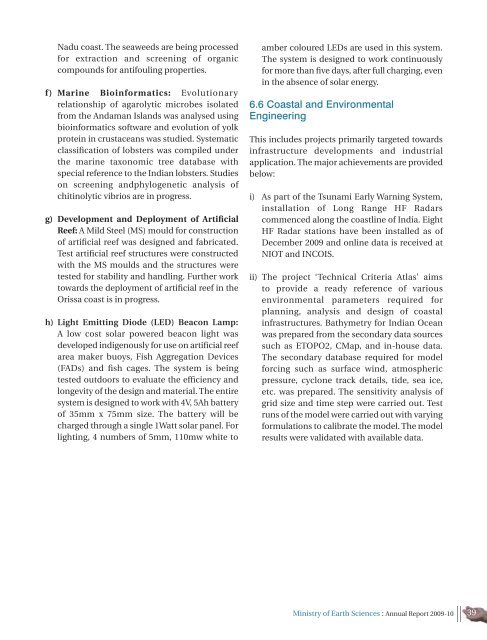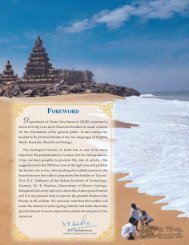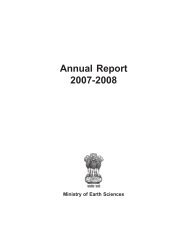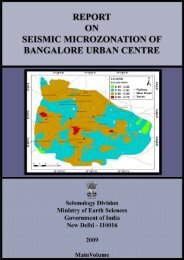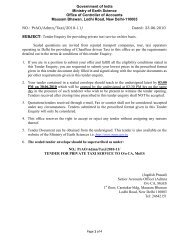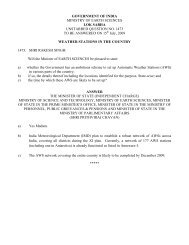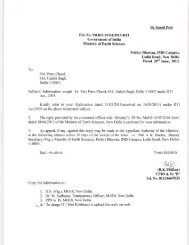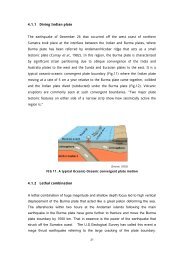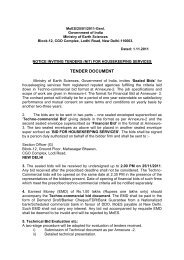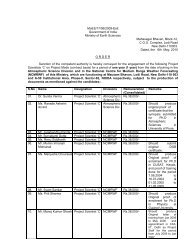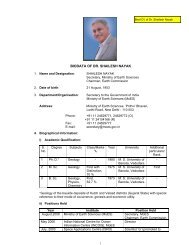Annual Report 2009-2010 - Ministry Of Earth Sciences
Annual Report 2009-2010 - Ministry Of Earth Sciences
Annual Report 2009-2010 - Ministry Of Earth Sciences
Create successful ePaper yourself
Turn your PDF publications into a flip-book with our unique Google optimized e-Paper software.
Nadu coast. The seaweeds are being processed<br />
for extraction and screening of organic<br />
compounds for antifouling properties.<br />
f ) Marine Bioinformatics: Evolutionary<br />
relationship of agarolytic microbes isolated<br />
from the Andaman Islands was analysed using<br />
bioinformatics software and evolution of yolk<br />
protein in crustaceans was studied. Systematic<br />
classification of lobsters was compiled under<br />
the marine taxonomic tree database with<br />
special reference to the Indian lobsters. Studies<br />
on screening andphylogenetic analysis of<br />
chitinolytic vibrios are in progress.<br />
g) Development and Deployment of Artificial<br />
Reef: A Mild Steel (MS) mould for construction<br />
of artificial reef was designed and fabricated.<br />
Test artificial reef structures were constructed<br />
with the MS moulds and the structures were<br />
tested for stability and handling. Further work<br />
towards the deployment of artificial reef in the<br />
Orissa coast is in progress.<br />
h) Light Emitting Diode (LED) Beacon Lamp:<br />
A low cost solar powered beacon light was<br />
developed indigenously for use on artificial reef<br />
area maker buoys, Fish Aggregation Devices<br />
(FADs) and fish cages. The system is being<br />
tested outdoors to evaluate the efficiency and<br />
longevity of the design and material. The entire<br />
system is designed to work with 4V, 5Ah battery<br />
of 35mm x 75mm size. The battery will be<br />
charged through a single 1Watt solar panel. For<br />
lighting, 4 numbers of 5mm, 110mw white to<br />
amber coloured LEDs are used in this system.<br />
The system is designed to work continuously<br />
for more than five days, after full charging, even<br />
in the absence of solar energy.<br />
6.6 Coastal and Environmental<br />
Engineering<br />
This includes projects primarily targeted towards<br />
infrastructure developments and industrial<br />
application. The major achievements are provided<br />
below:<br />
i) As part of the Tsunami Early Warning System,<br />
installation of Long Range HF Radars<br />
commenced along the coastline of India. Eight<br />
HF Radar stations have been installed as of<br />
December <strong>2009</strong> and online data is received at<br />
NIOT and INCOIS.<br />
ii) The project ‘Technical Criteria Atlas’ aims<br />
to provide a ready reference of various<br />
environmental parameters required for<br />
planning, analysis and design of coastal<br />
infrastructures. Bathymetry for Indian Ocean<br />
was prepared from the secondary data sources<br />
such as ETOPO2, CMap, and in-house data.<br />
The secondary database required for model<br />
forcing such as surface wind, atmospheric<br />
pressure, cyclone track details, tide, sea ice,<br />
etc. was prepared. The sensitivity analysis of<br />
grid size and time step were carried out. Test<br />
runs of the model were carried out with varying<br />
formulations to calibrate the model. The model<br />
results were validated with available data.<br />
<strong>Ministry</strong> of <strong>Earth</strong> <strong>Sciences</strong> : <strong>Annual</strong> <strong>Report</strong> <strong>2009</strong>-10 39


